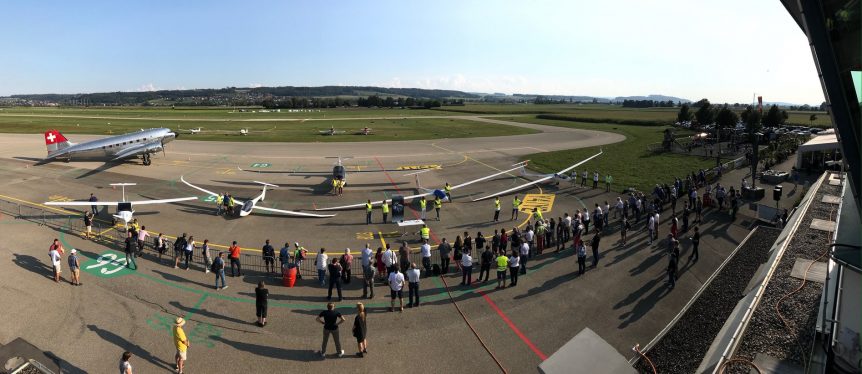Grenchen, Switzerland’s airfield hosted the fourth electric fly-in on that site over the weekend of September 11 and 12. No fewer than 16 different electric craft flew in or were on hand to greet the lucky visitors. Even celebrities were there, including Solar Impulse pilot Bertrand Piccard and Olympic champion, astrophysicist and pilot Dominique Gisin. The Grenchner Tagblatt (daily news) was on hand to report on the proceedings, and seems to have come away impressed with the turnout and the technology. The paper reported this sidelight on the recent record-setting trip from Switzerland to the North Sea of Germany in a Pipistrel Velis (also on display on the field). “Lush parties were celebrated almost everywhere, all under the sign of electromobility, which according to Westermann must be the only possible future. Incidentally, the record aircraft had also been brought to Grenchen and could be viewed at close range. An amusing detail on the side: Westermann said that despite enormous media coverage, around …
e-Genius Extends Its Range
Shown at the E-Flight Expo at Friedrichshafen’s Aero 2015, Stuttgart University’s e-Genius had an aerodynamic-looking pod next to one wing, containing an ENGIRO range extender consisting of a Wankel-type engine and a generator. The unit could, as its name implies, help e-Genius go for new records to add to its already significant collection. Bill Lofton at EV Hangar has detailed the extender, now associated with the e-Genius and in a larger variant on the Equator P2 amphibian being built in Norway by Tomas Broedreskift. Equator’s web site describes its power system: “The hybrid propulsion system being developed by Equator is called EHPS (Equator Hybrid Propulsion System). The engine specific project is being co-funded by Transnova and the company doing the development work with us on this is ENGIRO. We will design a custom engine and generator specified specifically for the P2. Power out in the prop is 100kW (approx. 130HP) and the generator will produce 57-60kW of power charging the batteries. The combustion …
EAS VIII: Klaus Ohlmann Conquers Everest
Klaus Ohlmann says the sailplanes and solar-powered aircraft in which he has set several world records are powered by a “gravitational engine with an external fusion reactor.” He has been on a sun-stoked roll the last few years. His recounting of the epic journey first to fly a Stemme motorglider from Germany to Katmandu, and then to conquer Mount Everest in a sailplane, kept the eighth annual Electric Aircraft Symposium audience enthralled. That feat alone would be enough for admiration, but his seemingly never-ending series of adventures provoke a bit of awe. He is a member of the Mountain Wave Project (MWP), a group which explores high-altitude weather systems to verify theoretical considerations. As stated in the MWP’s web site, it is “a project of the scientific and meteorological panel of OSTIV (Organisation Scientifique et Technique du Vol à Voile) …conceived during an OSTIV seminar 1998 in Serres/France by René Heise and Klaus Ohlmann and attracted several enthusiastic scientists/pilots since.” He holds the world’s …
Green Speed Cup – Training Day is Over and Day One Establishes a Record
Happily for those of us who champion the idea of electric aircraft, the practice day and day one of the Green Speed Cup in Strausberg, Germany fetched a world electric aircraft distance record for e-Genius and an outstanding showing for all concerned. This beginning for the third running of the Cup sets a high standard for the coming days. The Green Speed Cup has elements of soaring flight through the use of thermals, careful speed flying that emphasizes fuel economy, and precise flight planning with attention to the planned route, winds aloft, and power settings. Green Speed Cup organizers map out a series of triangular routes to test the limits of piloting skills and airplane efficiency. As the organizers explain, it’s all pretty simple: “To fly ‘green’ you have to know how fast to fly and which power setting to use. This depends on the current wind-profile, on the current lift and on several other parameters like the aerodynamical properties.” …
Flying e-Genius for Two Years
At this year’s Electric Aircraft Symposium, Rudolf Voit Nitschmann, Len Schumann, and Ingmar Geiss shared their well-documented experiences with e-Genius, second place winner in 2011’s Green Flight Challenge. Flown by Erik Raymond and Klauss Ohlmann, the airplane managed 397.5 passenger miles per gallon on its 200-mile trek around a closed circuit between Santa Rosa, California and the distant geothermal power plants that provided the electricity for its flight. As Voit Nitschmann, leader of the e-Genius team since 2005 noted, one must design electric aircraft around the beneficial aspects of such vehicles to gain the greatest performance. Originally slated to be hydrogen powered, e-Genius mounts its 59-pound motor on the leading edge of the vertical rudder, more difficult with a heavier internal-combustion engine. This permits ample propeller clearance, provides blade protection and allows a short, retractable landing gear that is light and simple. With no turbulent flow over the nose, the cockpit can be streamlined like that of a sailplane and …

